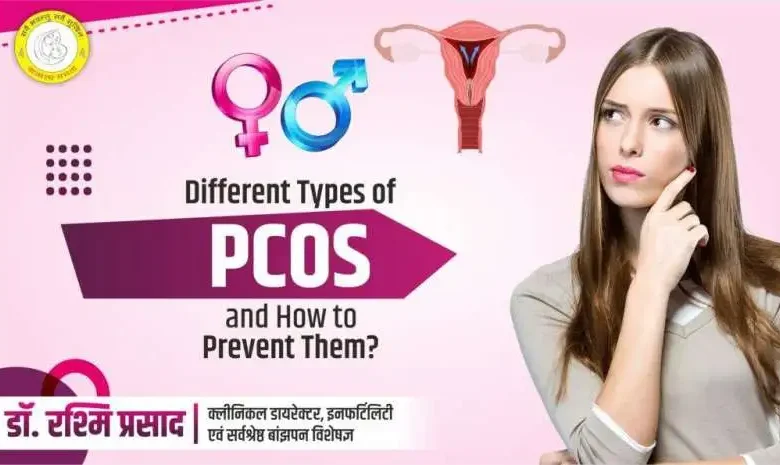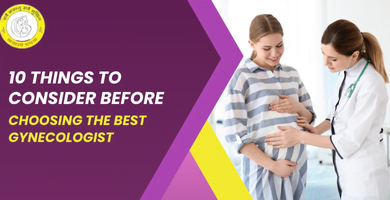Different Types of PCOS and How to Prevent Them?

Polycystic Ovarian Syndrome (PCOS) is not a single disease. PCOS is a complex hormonal disorder that affects women of reproductive age. There are several types of PCOS.
In other words, it is a collection of symptoms (androgen excess, and ovulatory cycles) caused by multiple underlying factors. You must identify the element causing your symptoms to treat PCOS successfully. You need to identify your functional types of PCOS.
Understanding PCOS: What You Need to Know About It
In this Article
Polycystic Ovarian Syndrome (PCOS) is a condition where the ovaries produce abnormal amounts of androgens, male sex hormones, which are often present in low levels in women. Polycystic Ovary Syndrome is a term that refers to the small cysts (fluid-filled sacs) that develop in the ovaries. Cysts can develop in some women, but not all.
The ovary releases a mature egg, which is ovulation, to enable fertilization with male sperm. If the egg remains unfertilized, the body expels it during the period, which can cause additional menstrual issues and PCOS symptoms for the woman.
Common Symptoms of PCOS in Women
Different people have different levels of PCOS. Contrary to the name PCOS, not all women with it have extra follicles. Not all women with polycystic Ovaries (PCOS) have them.
- Difficulty Getting Pregnant: PCOS can make it difficult for women to get pregnant. PCOS is the leading cause of female fertility. Problems with fertility arise from insufficient ovulation. It doesn’t mean a woman will ovulate even if her period is late. It is possible to get her period without ever ovulating. This is why a woman might not realize something is wrong until she has been trying to become pregnant for some while.
- Hair loss: You may lose the hair you want. Women may experience “male pattern” hair fall due to excess androgens. This is when the hair falls out at the top of the head.
- Periods: PCOS is characterized by irregular periods, irregular menstrual cycles, and a lack of regular periods. Periods that last longer than usual are also common signs of PCOS. You might experience at most nine periods per year, for example. These periods could also occur at different times, such as 35 days apart.
Understanding the Causes of PCOS
It is not known what exactly causes PCOS. Evidence suggests that genetics may play a part in PCOS. Other factors may also play a role in the development of PCOS.
- High androgen levels: High androgen levels can prevent the ovaries from releasing eggs (ovulation). This causes irregular menstrual cycles. Tiny, fluid-filled sacs can form in the ovaries if there is an irregularity. High androgen levels in women can also cause excessive hair growth and acne.
- Low–grade inflammation: People with PCOS are more likely to experience chronic low-grade inflammation. Your healthcare provider can perform a blood test to determine the degree of inflammation in your body.
Exploring the 4 Types of PCOS
To effectively reverse the symptoms of PCOS and treat it naturally, you must first identify which type of PCOS you have. These are the four types of PCOS:
- Insulin-resistant PCOS: This is the most common form of PCOS and affects approximately 70% of people. Hyperinsulinemia is a condition where insulin levels are higher than usual. Insulin effects can cause the pancreas and other organs to produce more insulin when our cells are less responsive to it. This PCOS can cause weight problems, weight control issues, sugar cravings, and fatigue. High insulin levels can cause excess hair, male-pattern hair loss, and acne.
- PCOS – Pill-Induced: The second most common type of PCOS is pill-induced. Birth control pills are used to stop ovulation. Your ovaries will begin to function again once you have stopped taking the medication. You should also get a monthly period to re-establish ovulation. Some women may experience suppressed ovulation for months or years after taking the pill, known as pill-induced PCOS.
Adrenal PCOS:
This type of PCOS results from an abnormal stress response. Less common of the 4 types of PCOS, It affects approximately 10% of people diagnosed. This is most common during stressful times. High levels of DHEA and cortisol are indicators. Elevated DHEA-S, an additional type of androgen from the adrenal glands, usually occurs, but high levels of testosterone or androstenedione won’t be observed. This type of androgen is only tested occasionally unless an endocrinologist, functional medicine specialist, or other medical professional recommends it.
- Inflammatory PCOS: Inflammatory PCOS can also be a type within the functional medicine community. The good news is that the two types of PCOS are almost identical, with one crucial difference. Other factors such as physiological or environmental reactions can cause bodily inflammation. Medical professionals refer to inflammatory PCOS as “hidden-cause” PCOS, which includes food sensitivities, intestinal permeability, environmental toxins, thyroid disease, and other autoimmune disorders.
Also, Read the next article: Difference between PCOD & PCOS?
Effective Treatments for PCOS
The PCOD/PCOS treatment focuses on managing problems including irregular periods, obesity, infertility, and acne. The first step in treatment is usually making lifestyle changes such as weight loss, diet, and exercise. A 5-10% weight loss can help regulate periods.
The symptoms of hair loss, acne, and metabolic disorders will determine the treatment. These include:
- Prescriptions to correct hormonal imbalance and insulin resistance can regulate the menstrual cycle.
- Oral medicines and injections can induce ovulation (the quantity and quality of ovulation).
- Doctors use fertility drugs to treat infertility
- Reduce excessive hair growth
- If hormonal treatment does not work for PCOS patients, doctors use a laparoscopic procedure to drill the ovaries.
Any diet can achieve weight loss. Some diets have more advantages than others. Weight loss can improve cholesterol, lower insulin levels, and reduce the risk of heart disease and diabetes. Women can lose weight by exercising 20 minutes daily at moderate intensity, at least five times per week. Exercise can help you lose weight and improve your ovulation.
PCOD and PCOS can be treated with timely diagnosis and appropriate treatment. It is essential to maintain a healthy lifestyle to treat hormonal imbalances and other related conditions.
Conclusion
It can be hard to navigate PCOS on your own. It is a complex hormonal disorder and can take time to overcome. The 4 types of PCOS that have been successfully discussed required a proper medical diagnosis before treatment can start. Contact a Gynaecologist Doctor in Patna if you are tired of hormonal contraception or want to have a family.
FAQs
Difference Between PCOS and PCOD
PCOD (Polycystic Ovary Disease) is a common condition where the ovaries produce immature eggs, leading to hormonal imbalances and swollen ovaries.
PCOS (Polycystic Ovary Syndrome) is a more serious hormonal disorder where the ovaries produce excess male hormones (androgens), causing cysts to form.
can PCO cause weight loss
No, PCOS is often associated with weight gain, not weight loss. However, weight management is important for managing PCOS symptoms.
What are the first signs of PCOS
The first signs of PCOS can vary but often include:
Irregular periods
Acne
Excess body hair (hirsutism)
Weight gain
Thinning hair
How to stop PCOS hair loss
Hair loss in PCOS is often due to hormonal imbalances. While there’s no guaranteed cure, these steps can help:
Consult a doctor: They can prescribe medications or treatments to balance hormones.
Healthy lifestyle: Regular exercise, balanced diet, and stress management can improve overall health.
Hair care: Gentle hair care products and avoiding harsh treatments can help prevent further damage.



